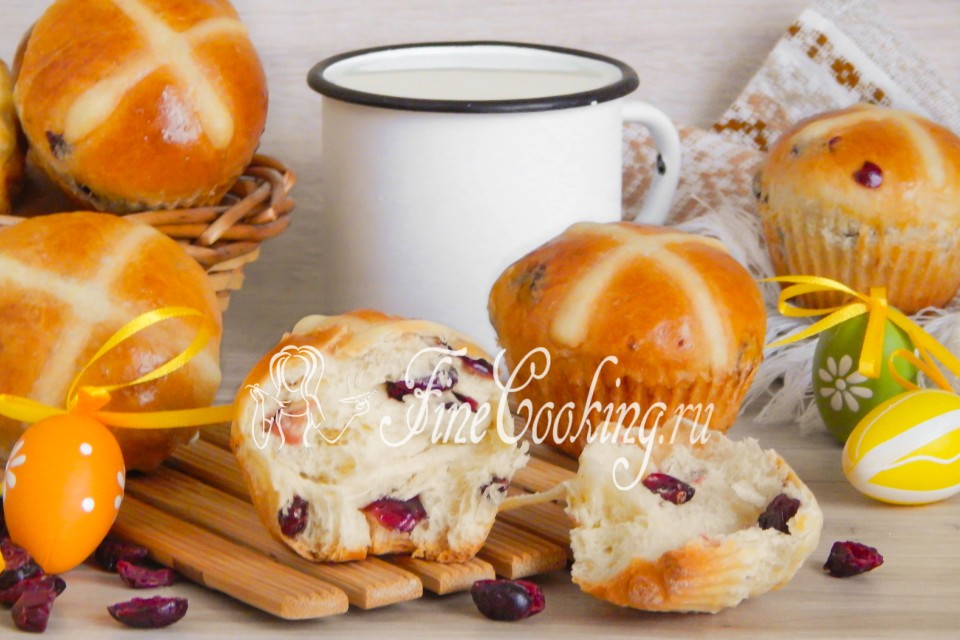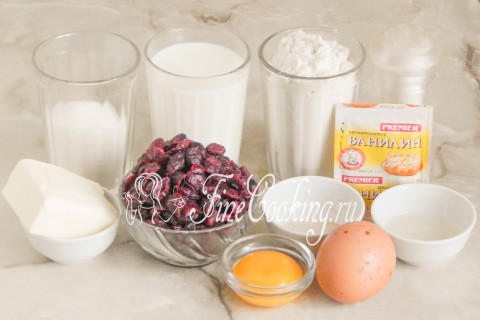Step 1
To prepare Easter buns, we take the wheat flour of the highest grade, milk of any fat content (I use 2.5%), medium-sized chicken egg (45-50 grams) and egg yolk, sugar, butter (with fat content of 72-82%), salt, refined vegetable oil (I will write about yeast slightly lower) and I will write a little below) and Vanilin. As a filler, I propose to use dried cranberries — I wrote about possible replacement options above.
Step 2
Sifting (preferably twice) wheat flour of the highest grade in a bowl. Due to this, the flour is not only loosened and saturated with oxygen, but possible garbage will also leave. Perhaps you need a little less or more flour — it depends on its quality (in particular humidity). That is why I would advise you to use not all the flour at once, but take 450 grams to begin — then you will navigate the consistency of the dough.
Step 3
Add fast yeast to flour (1 teaspoon with a hill — this is 5 grams), granulated sugar, a pinch of vanillin (teaspoon of vanilla sugar) and salt. Mix everything thoroughly with a fork or a whisk. About yeast: it is not necessary to take precisely fast -acting ones — just dry are perfect (also 5 grams — this is a teaspoon with a hill) or pressed (it is needed 3 times more, that is, 15 grams). Such yeast is not immediately mixed with flour, but previously activated in a warm sweetish liquid for 10-15 minutes. In our case, you can slightly heat half a glass of milk with a tablespoon of sugar and dissolve the yeast in it.
Step 4
In the flour mixture we make a recess and pour warm (not hot, namely pleasant warm) milk into it, break one chicken egg. Mix everything with your hand or spoon so that the flour is moistened.
Step 5
When you get such flour lumps, you can introduce melted, slightly warm butter. We begin the knead of the dough with our hands or with the help of dough (bread makers).
Step 6
To knead this yeast dough needs for a long time — at least 10 minutes, and even better longer. As a result, you will get a smooth, completely homogeneous dough. It should be soft and very sticky. At the same time, the yeast dough holds the shape perfectly, it is quite elastic and elastic. As I wrote above, in the process of kneading it may be needed a little more or slightly less flour than I indicated in the ingredients — it depends on its humidity. Add dried cranberries (or other filler) and interfere with the dough until the berries are evenly distributed throughout the volume.
Step 7
We roll up the dough into the ball and leave it in a bowl (I am always my dishes in which the dough roams — I just do not like dirty). We send the dough to heat for 1 hour, after which we make a light degree, re -rounding and again in heat for another 1 hour. Where is it better to wander the test and what does a warm place mean? There are several options. First of all, in the oven with a light bulb turned on (it turns out about 28-30 degrees — the temperature ideal for fermentation of yeast dough). Then we tighten the bowl with the dough with cling film or cover with a towel made of natural fabric (flax is best suited) so that the surface does not be swollen and not covered with a crust. You can also let the dough wander in a microwave, in which we pre -boil a glass of water. The dough will rise with a door closed, and the glass will stand there. Then the bowl does not need to be closed with anything, since the water will evaporate, thereby maintaining the necessary humidity. Just make sure that no one inadvertently turns on the microwave, otherwise the dough will disappear and there will be no Easter buns.
Step 8
After about 1 hour, the yeast dough is well suited in warmth — it will grow in volume at least 2 times.
Step 9
We crush it, releasing excess gas, round and again in a warm place for another 1 hour.
Step 10
For the second time, the yeast dough will grow even more — exactly 2.5 times, and maybe more. By the way, I want to talk a little about the time of fermentation of the yeast dough and the proofing of the workpieces. I hope you understand that this concept is relative. What does it mean? Well, for example, the recipe says that the test should be given to rest for 1 hour. You understand that 1 hour is the time that the author of this recipe was needed. +/- 10-15 minutes- quite acceptable deviation, the entire time of fermentation of the yeast test depends on many factors. Freshness (and as a result of activity) of yeast, the quality of flour, the temperature in the room, the amount of dough — this all affects the time of fermentation and proofing. Therefore, never clearly follow these recommendations — you must feel the dough, understand what he needs and then you will cook it purely intuitively.
Step 11
We divide the dough into pieces of the same size — I have 20 pieces, each I weighed. It is very convenient to use kitchen weights so that the blanks are of the same weight. This is important not only from an aesthetic point of view, but also in order for the baking to evenly part and bake the same way. You can divide the dough into as many parts as you need. We roll each piece into a ball (how to do this, you can see in this recipe).
Step 12
Easter buns can be baked both on a baking sheet and in form or molds. In the first case, the buns will not turn out very high, while in the form they will grow up. We cover the baking dish or a baking sheet with parchment paper (then we don’t need to lubricate it) or lubricate with a thin layer of vegetable oil without smell. I decided to bake buns in cupcakes and muffins — lubricated them with a thin layer of vegetable oil and laid the balls of the dough with a seam down. We cover the workpieces with a light towel made of natural fabric or cling film. We leave in a warm place for about 1.5 hours.
Step 13
While future Easter buns are parted, we will make the dough for drawing crosses. We put all the ingredients in a bowl: flour, milk, salt, sugar and vegetable oil without smell.
Step 14
Mix everything thoroughly so that there are no lumps left. According to the consistency, the drawing dough should not turn out thick, but it should not pour it. If necessary, adjust its density by adding flour or milk. For a sample, scoop up a little dough with a spoon and try to draw a thin strip — it should keep in shape and not spread in a puddle.
Step 15
We transfer the dough to a bag or a cornet — then cut a thin hole with scissors so that you can draw on the blanks. Along the way, prepare a lubricant for future buns: just mix the egg yolk and a tablespoon of milk.
Step 16
When the blanks grow up well and increase in volume at least twice, they still bake them. Before planting, apply a white dough from a bag in the form of crosses. Gently grease open places on top with a mixture of yolks and milk.
Step 17
We bake Easter buns in a preheated oven at an average level at 180-185 degrees. Baking time varies from 25 to 40 minutes (depending on the size of the workpieces). My buns spent 30 minutes in the oven — they rose well and creeped beautifully, while the crosses remained bright.
Step 18
Let the Easter buns cool a little in the molds, after which we take them out and let it cool completely. The buns is very fragrant, with a thin crust, the most delicate crumb and pleasant pieces of dried cranberries. A glass of milk or a cup of tea is an excellent addition to this delightful home baking. Prepare for health, friends!


















